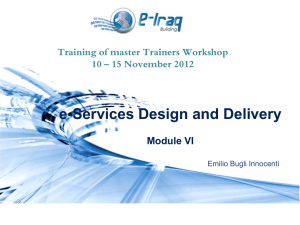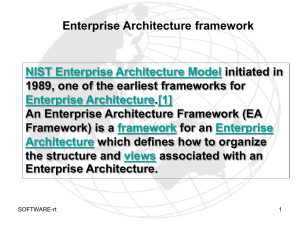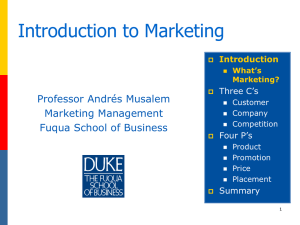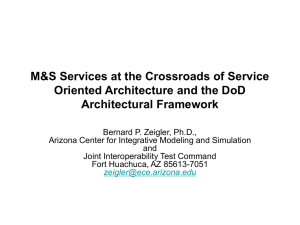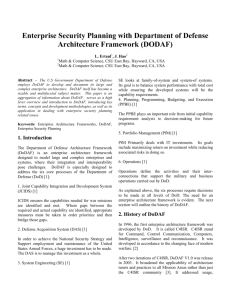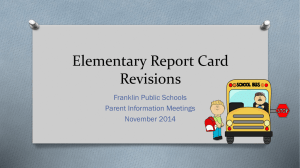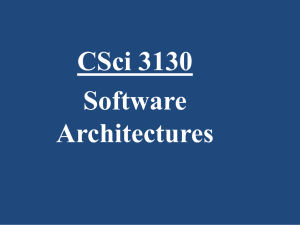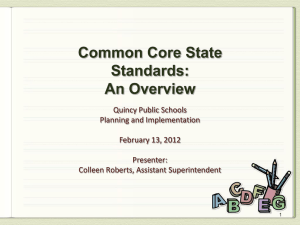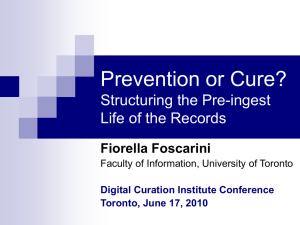architecture framework
advertisement
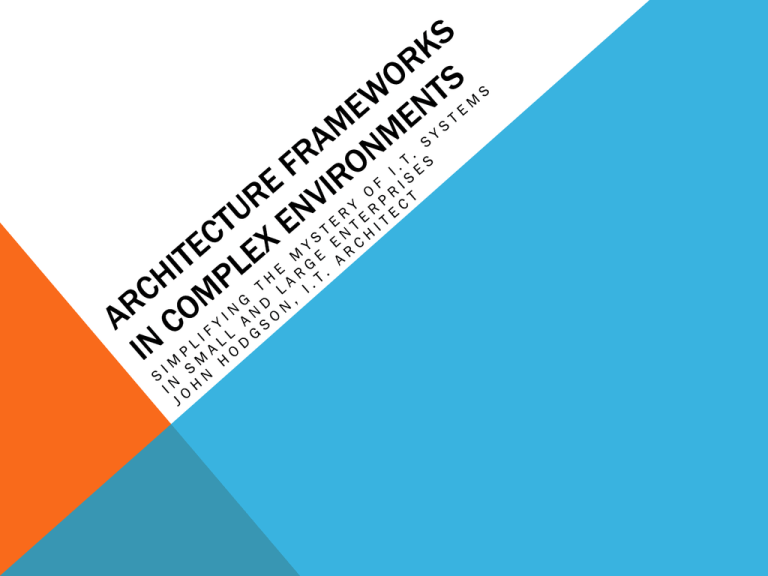
WHAT ARE ARCHITECTURE FRAMEWORKS? ISO/IEC/IEEE 42010 defines architecture framework and specifies requirements on architecture frameworks. architecture framework: conventions, principles and practices for the description of architectures established within a specific domain of application and/or community of stakeholders Requirements on Frameworks An architecture framework conforms to the International Standard (IS) when it specifies: • information identifying the framework; • one or more concerns; • one or more stakeholders having those concerns; • one or more architecture viewpoints (and their specifications conforming to the IS); • correspondence rules, integrating the viewpoints (per 5.7 of IS); • conditions on applicability (per 6.1 of IS); • consistency of the framework with the provisions of the ISO/IEC/IEEE 42010 conceptual model. (see also: Meta model matters) Survey of Frameworks http://www.iso-architecture.org/ieee-1471/afs/frameworks-table.html (118 different frameworks and methodologies recognised) RECENT INFLUENCES ON ARCHITECTURE FRAMEWORKS • SOA - Services Orientated Architecture development • Capability language – Drifting into common business use • Technology as a commodity - SAAS, Cloud, Virtualisation, Standardisation, Open Technology, Public Networks. • Standardisation of Government and Business Processes – across Enterprises, Countries and Government Layers. “Interoperability” • Growing reliance on standard processes embedded in COTS WHY USE ARCHITECTURE FRAMEWORKS? 1. A standard Common Language between I.T. Professionals and Business 2. Allows some re-use of previous architectural development and products 3. Collects together the experience of those who came before 4. Makes I.T. skills, investments and developments of greater value to business and government. (i.e. WE become of greater value to business owners & executives) 5. Provides a “structure” to collect, guide and analyse information about information and “things”. 6. Can allow unskilled individuals to “visualise” the logical linkages between very diverse entities (i.e. A process in a business to the level of profit made by the business; the actual business value of an I.T. system to a Government Agency). IMPORTANT FRAMEWORKS IN CANBERRA AGAF – Australian Government Architecture Framework - AGIMO (circa 2008) FEAF - Federal Enterprise Architecture Framework – USA Federal Government AUSDAF – Australian Defence Architecture Framework – ADF TOGAF – The Open Group Architectural Framework – The Open Group MODAF – Ministry of Defence Architecture Framework – UK MOD DODAF – Department of Defence Architectural Framework – US DoD Zachmann – One of the original frameworks still in commercial use – Zachmann Gartner – Combination of META Group and Gartner Enterprise Frameworks What do these have in common? COMMON FRAMEWORK ATTRIBUTES • Methodology to develop and use architectural elements in an Enterprise • Governance, Business and Technical aspects • Views appropriate to the intended audience • Very few “mandatory” elements. • Big focus on “just in time”; “fit for purpose” and simplification • Big difference between Architecture and Design We will focus on DODAF V2: • Probably the “richest” structure as it targets the most complex of developments. • US DoD and USAAF have invested a “motsa” on developing detail and how to guides. • There is a lot of “how to” material available on the Internet (Google “DODAF V2”) • DODAF views seem to fit into every other Framework methodology DODAF V2.02 (CURRENT VERSION 2010) US DoD’s understanding how DODAF views fit together…. Project Viewpoint Articulate operational scenarios, processes, activities & requirements Services Viewpoint Articulate the performers, activities, services, and their exchanges providing for, or supporting, DoD functions Standards Viewpoint Operational Viewpoint Systems Viewpoint Articulate the legacy systems or independent systems, their composition, interconnectivity, and context providing for, or supporting, DoD functions Describes the relationships between operational and capability requirements and the various projects being implemented; Details dependencies between capability management and the Defense Acquisition System process. Articulate the capability requirement, delivery timing, and deployed capability Overarching aspects of architecture context that relate to all models All Viewpoint Articulate the data relationships and alignment structures in the architecture content Data and Information Viewpoint Articulate applicable Operational, Business, Technical, and Industry policy, standards, guidance, constraints, and forecasts Capability Viewpoint AGAF STRUCTURE (CIRCA 2011) 1 Whole-of-Government Enterprise Architecture Program The intent of this Australian Government Architecture (AGA) framework is to assist in the delivery of more consistent and cohesive services to citizens and support cost-effective delivery of Information and Communications Technology (ICT) services by government, providing a framework that: provides a common language: provides a common language for agencies involved in the delivery of cross-agency services enhances collaboration: supports the identification of duplicate, re-usable and sharable services assists in describing and analysing IT investments: provides a basis for the objective review of investment by government assists in transforming Government (citizen-centric, results-oriented, market-based): enables more cost-effective and timely delivery of ICT services through a repository of standards, principles and templates that assist in the design and delivery of ICT capability and, in turn, business services to citizens. This is the third release of the reference models. The reference models form the basis of a common language between agencies and structure a repository of architectural artefacts (including standards, guidelines, designs and solutions) that may be used by agencies to deliver an increasing range of whole-of-government services. It introduces the Performance Reference Model and the Metamodel. AGA REFERENCE MODELS Reference Models are the core of AGAF (because the focus is Cross-Agency) AGAF FOCUS ON MEASUREMENT When implemented within an agency, the measurement framework delivers a line of sight for agency executives to the resource inputs allocated to an initiative (program, project, section, branch or division) and the intended outcomes of that initiative. The line of sight also captures the efficiency and effectiveness of the work processes involved, the quality of outputs produced and the impact of output usage levels by targeted customers. There are five measurement domains within the AGA PRM: Inputs; Processes and Activities; Outputs; Usage; and Outcomes. As detailed above, these domains correspond to the five discrete areas of activity described in the Government and Business Operation Model, the Inputs– Transformation–Outcome Model, and the Outcomes Process Model AGAF STRUCTURE (CIRCA 2011) AGAF Performance Reference Model (PRM) Classification Framework AGAF ARCHITECTURAL METAMODEL CASA ARCHITECTURAL REFERENCE MODEL BUSINESS LAYER LINKAGES AND CROSS REFERENCES

